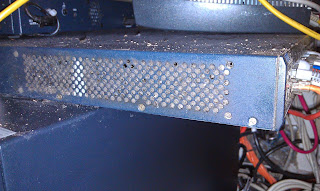This little device which much like a Wireless Access Point is actually not. Its roll is to sniff the wifi frequencies in search rogue wi-fi networks and war-drivers.
Monday, April 28, 2014
Sunday, April 27, 2014
Smart jack

A "Smart Jack" is usually the point at which the telephone company hands-off the circuit to the customer. This is also referred to as a "demark" (or demarc or point-of-demarcation). It also had the roll of acting as a control and trouble-shooting device for the phone company. For instance, the tech on the phone company side can communicate with the smart jack. She can put the smart jack into a Loopback mode which would allow her to run diagnostics on the span. This helps ddetermineif any trouble in the network is on the phone company side or on the customer side.
DUST - Why hardware overheats!
There are three top killers of Network equipment (or all electronics for that matter).
1. Lightning
2. irregular power (power surges and sags)
3. Heat
This article addresses HEAT.
Even with the most expensive network / server installations, no one is ever appointed as the :"person to be sure the equipment is kept clean, dust-free, and climate-controlled". A professional IT admin should know this, but I've rarely seen one with a dust cloth or a vacuum.
However, dust-control is so disparately needed. With the exception of formal data centers (which are self-cleaning due to air circulation systems that filter the air), any installation will begin to accumulate dust within a few months.
Almost any enterprise-grade switch, server, or router has a fan in it which spins 24/7. As it does it's pulling dust into the device it is trying to cool. Again, unless the air is very well filtered (as it is in a data center), all air contains some dust.
Dust begins to accumulate on the vents, the fan blades and the components inside the device. As it does, three things start to happen.
1. The vents let less air in (now the fan is working harder which leads to failure)
2. The fan blades become less efficient because they are no longer smooth (they are caked with dust)
3. components that accumulate dust now cannot be cooled as easily because the dust is acting like blanket to keep heat inside.
1. Lightning
2. irregular power (power surges and sags)
3. Heat
This article addresses HEAT.
Even with the most expensive network / server installations, no one is ever appointed as the :"person to be sure the equipment is kept clean, dust-free, and climate-controlled". A professional IT admin should know this, but I've rarely seen one with a dust cloth or a vacuum.
However, dust-control is so disparately needed. With the exception of formal data centers (which are self-cleaning due to air circulation systems that filter the air), any installation will begin to accumulate dust within a few months.
Almost any enterprise-grade switch, server, or router has a fan in it which spins 24/7. As it does it's pulling dust into the device it is trying to cool. Again, unless the air is very well filtered (as it is in a data center), all air contains some dust.
Dust begins to accumulate on the vents, the fan blades and the components inside the device. As it does, three things start to happen.
1. The vents let less air in (now the fan is working harder which leads to failure)
2. The fan blades become less efficient because they are no longer smooth (they are caked with dust)
3. components that accumulate dust now cannot be cooled as easily because the dust is acting like blanket to keep heat inside.
 |
| Vents on a Juniper switch almost 100% clogged by dust |
I see this so often when working in the field - clogged vents. And, you can hear the whine of the fan running at full speed desperately trying to cool the CPU.
I don't blame the staff at the locality, they don't know any better.
Usually, if I have time, I will attempt to remedy the situation. But, as a field tech, one has to be careful about touching stuff that is not in the scope of what you were sent there to work on. The old cliche applies - "No good deed goes unpunished!"
 |
| POS terminal with dust clogging vents |
What will help?
Simply making it a point to dust and vacuum around the network equipment once every 3 months would be a great start. If you want to go a little farther, invest in a air filter big enough for the room your data equipment is located-in. Ideally, network and server equipment should be kept in a small room with a closed door. However, in many small business settings this is often not the case. It's usually stacked on some shelves in the accounting office or in the storage closet.
Another Heat Source - STUFF!
The other big enemy in the war-on-heat, is inadequate breathing room. When a device (network switch, server, stereo, microwave) has items placed on top of it, or leaning up against it, this blocks the heat-dissipation path. Which way does hot air normally move? UP! Of course. When you stack items or place things on top of a devices exterior, you're blocking the natural exit path for the heat.
Now, somethings are designed to be stacked. For instance high quality switches like Cisco or Juniper were designed with the idea that they would be stacked. So, in that case stacking is OK. But, may consumer-grade networking components are not. If you were to take consumer-grade router (which usually has heat vent holes on top) and set another component directly on top of it, you would be reducing the natural flow of heat.
Gotcha Cornered
The last problem I can think of is that after the network equipment is installed, other (non-technical) people come in a try to push-back or slide the equipment up against the wall so they can re-claim the unused space. The problem with this is that it blocks the vents. Most "pizza box" style networking components pull air in through the left and right side walls. But, when people push these components up against the wall, they completely block the vents on one side (or sometimes both sides).
What to do???
If you're planning the installation, or you have the ability to move the equipment. Try to put the equipment up above eye level. This tends to keep people from unknowingly using the network shelf as a place to store things. Also, it would not hurt to put a sign up that says "DO NOT STORE ANYTHING ON THIS SELF".
Dusting: Just a quick swipe with the vacuum about once every 1-3 months. Or, use a "Swiffer" dust cloth. (those work really well).
In a perfect world, if you can install the equipment in a small climate-controlled room (or closet) with a door, that would be ideal
Subscribe to:
Posts (Atom)




